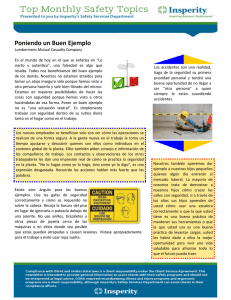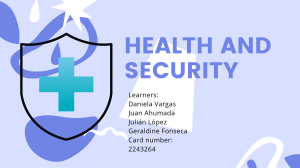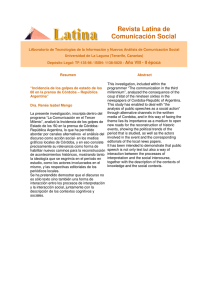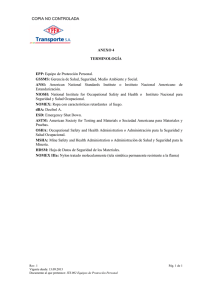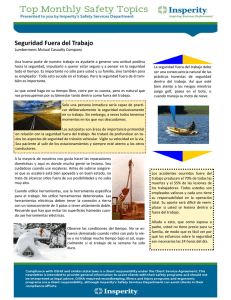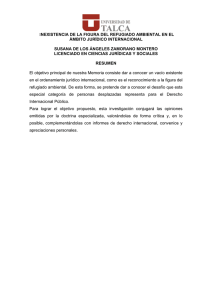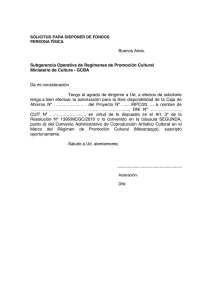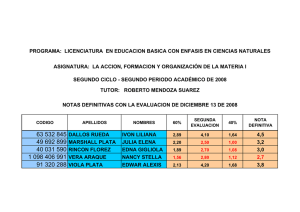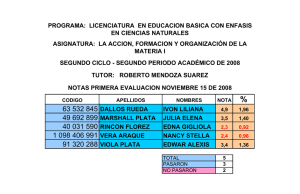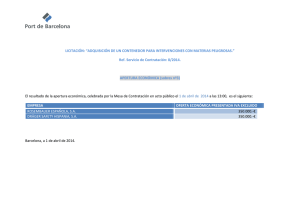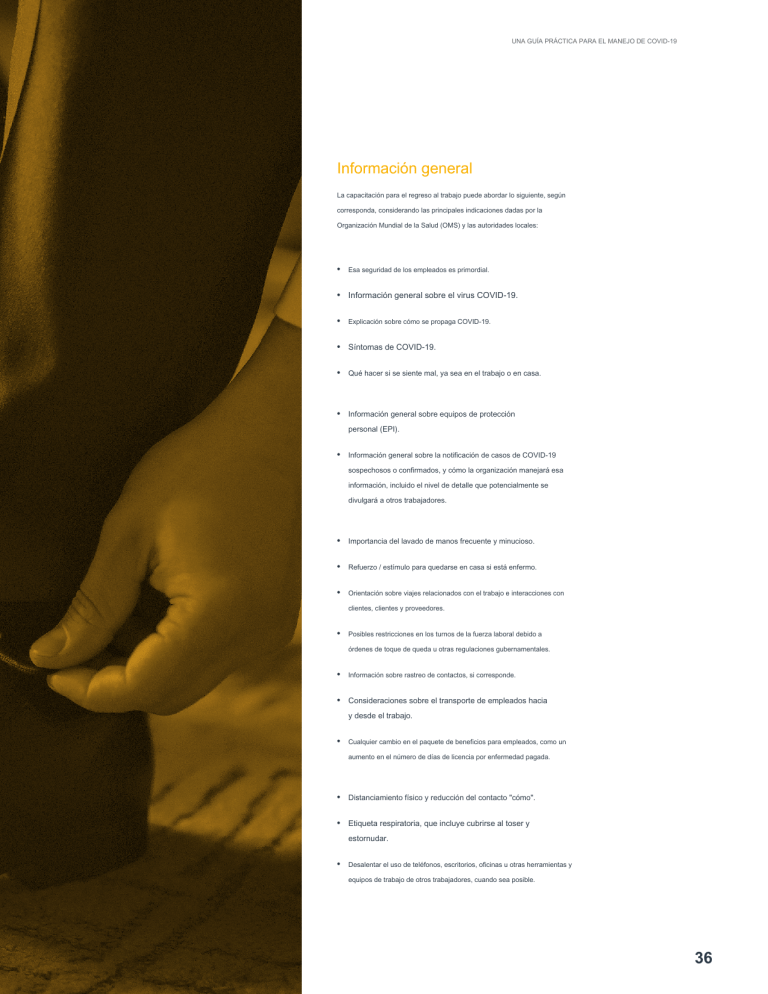
UNA GUÍA PRÁCTICA PARA EL MANEJO DE COVID-19 Información general La capacitación para el regreso al trabajo puede abordar lo siguiente, según corresponda, considerando las principales indicaciones dadas por la Organización Mundial de la Salud (OMS) y las autoridades locales: • Esa seguridad de los empleados es primordial. • Información general sobre el virus COVID-19. • Explicación sobre cómo se propaga COVID-19. • Síntomas de COVID-19. • Qué hacer si se siente mal, ya sea en el trabajo o en casa. • Información general sobre equipos de protección personal (EPI). • Información general sobre la notificación de casos de COVID-19 sospechosos o confirmados, y cómo la organización manejará esa información, incluido el nivel de detalle que potencialmente se divulgará a otros trabajadores. • Importancia del lavado de manos frecuente y minucioso. • Refuerzo / estímulo para quedarse en casa si está enfermo. • Orientación sobre viajes relacionados con el trabajo e interacciones con clientes, clientes y proveedores. • Posibles restricciones en los turnos de la fuerza laboral debido a órdenes de toque de queda u otras regulaciones gubernamentales. • Información sobre rastreo de contactos, si corresponde. • Consideraciones sobre el transporte de empleados hacia y desde el trabajo. • Cualquier cambio en el paquete de beneficios para empleados, como un aumento en el número de días de licencia por enfermedad pagada. • Distanciamiento físico y reducción del contacto "cómo". • Etiqueta respiratoria, que incluye cubrirse al toser y estornudar. • Desalentar el uso de teléfonos, escritorios, oficinas u otras herramientas y equipos de trabajo de otros trabajadores, cuando sea posible. 36 REGRESO AL TRABAJO SEGURO Información específica Las organizaciones deben trabajar con sus asesores legales y - Norma sobre equipos de protección personal (29 CFR 1910.132), que expertos en regulación para evaluar qué regulaciones se aplican a la requiere que los empleadores verifiquen que el equipo de empresa y determinar si se debe comunicar información específica a protección personal “se proporcione, use y mantenga en los empleados. Toda la información debe referirse a: condiciones higiénicas y confiables siempre que sea necesario para prevenir lesiones o enfermedades”. Directrices y publicaciones de la Organización Mundial de la Salud (OMS): https://www.who.int/emergencies/ enfermedades / nuevo-coronavirus-2019 / orientación-técnica - Estándar de protección respiratoria (29 CFR 1910.134), que proporciona protección a los trabajadores cuando se exponen a agentes infecciosos transmisibles por contacto, gotitas y en el aire. La norma de protección Directrices y publicaciones del Centro Europeo de Prevención y Control de Enfermedades de Alimentos (ECDC): https: // www. ecdc.europa.eu/en/covid-19-pandemic respiratoria se aplica al uso de respiradores estándar y quirúrgicos N95, N98, N99 y N100, pero no al polvo ordinario o máscaras quirúrgicas. Agencia Europea de Seguridad y Salud adWork (EU-OSHA): https://osha.europa.eu/en/themes/ - Si la organización está entregando una mascarilla facial covid-19-recursos-lugar de trabajo que no sea un respirador para su personal, entonces también debe considerar cómo minimizar la posibilidad de contaminar la mascarilla al colocarla, quitarla y guardarla. Autoridades locales de cada Estado miembro de la Unión Europea. - Si la organización no tiene otra opción que reutilizar un Las siguientes son las mejores prácticas tomadas de las normas y respirador debido a la disponibilidad limitada, las directivas de la Administración de Seguridad y Salud Ocupacional instrucciones deben incluir cómo desinfectarlo y la (OSHA) aplicables a la protección de los trabajadores: - Estándar de patógenos transmitidos por la sangre (29 CFR 1910.1030), que brinda protección a los trabajadores contra la exposición a sangre y fluidos corporales que puedan contener agentes infecciosos. 37 posibilidad de reducción de la eficacia atribuible al desgaste adicional. - Pautas para servicios sanitarios como desinfección de puntos de contacto alrededor de la instalación, incluidos pomos y manijas de puertas, manijas de gabinetes, accesorios de baño y botones de ascensores. UNA GUÍA PRÁCTICA PARA EL MANEJO DE COVID-19 Las organizaciones deben considerar adicional a la OMS indicaciones si ciertas Custodia COVID-19 los requisitos eran no forma parte de las tareas asignadas previamente. - La organización puede querer aumentar sus prácticas de - Estándar de protección ocular y facial (29 CFR limpieza, incluida una limpieza y desinfección más 1910.133), que señala que pueden ser posibles salpicaduras frecuentes de superficies, equipos y otros elementos del en la cara y los ojos durante las tareas de desinfección. entorno de trabajo. Al elegir productos químicos de limpieza, los empleadores deben consultar la información en las etiquetas de desinfectantes registrados por la EPA con declaraciones contra patógenos virales emergentes (consulte la Sección 5, Higiene del lugar de trabajo). - Las organizaciones deben considerar abordar la seguridad del puesto y las evaluaciones del EPP para cualquier tarea nueva o arreglos de trabajo creados por el potencial de presencia de COVID-19 y cómo minimizar los riesgos asociados con nuevos peligros en el lugar de trabajo. - Las organizaciones deben considerar indicaciones adicionales de la OMS si ciertos requisitos de custodia de COVID-19 no formaban parte de tareas asignadas. Los posibles temas de capacitación adicionales para los servicios de conserjería incluyen: - Norma de comunicación de peligros (29 CFR 1910.1200), que requiere capacitación de los empleados sobre los peligros de los materiales de limpieza como los desinfectantes, cómo pueden - La orientación posterior al COVID-19 debe reafirmar la preocupación de la organización por la seguridad y el bienestar de los empleados y revisar cualquier peligro clave de seguridad inherente a las operaciones como un medio para restablecer el énfasis de la organización en la seguridad ocupacional. Trabajar con el potencial adicional del riesgo de virus en el lugar de trabajo será una distracción que puede mitigarse mediante comunicaciones e información frecuentes. Nota: Consulte la Sección 12: Comunicaciones de respuesta y participación. protegerse y dónde encontrar copias de las Fichas de datos de seguridad de productos químicos correspondientes. - Norma de protección de manos (29 CFR 1910.138), que requiere protección de las manos cuando se utilizan materiales de limpieza y la selección de guantes de composición adecuada para los productos químicos en los desinfectantes. - Se recomienda a las organizaciones que trabajen con su asesor legal para monitorear los desarrollos en la OMS y otras regulaciones que puedan afectar las operaciones comerciales a fin de estar posicionadas para ajustar las comunicaciones internas en consecuencia. 38 REGRESO AL TRABAJO SEGURO 14 Revisiones de incidentes Comprender por qué ocurrió un incidente de seguridad para evitar que vuelva a suceder es fundamental para la mejora continua. Esta sección proporciona algunos consejos simples para guiar la revisión de un incidente, de modo que se pueda entender cualquier falla o falla en la respuesta COVID-19 o sus resultados y se puedan tomar las medidas correctivas apropiadas. Además, la información obtenida de dichas revisiones se puede utilizar como base para una instrucción de Aprendizaje de incidentes que se puede compartir ampliamente en toda la organización. Tu plan de acción Después de un resultado no deseado, como cuando ocurre una transmisión percibida de persona a persona de COVID-19 en un lugar de trabajo o cuando un control puede parecer insuficiente para evitar que ocurra un peligro, se debe realizar una revisión del incidente en consulta y coordinación con su el asesor legal de la organización. En su forma más simple, la revisión puede incluir los siguientes componentes en la página siguiente. 39 UNA GUÍA PRÁCTICA PARA EL MANEJO DE COVID-19 REGISTRE EL INCIDENTE The purpose of this step is to capture the facts. This can be done by determining: where the incident occurred, when it occurred, whowas present, what they were doing, andwhat was happening in the environment. This information can be captured by interviewing the parties concerned, reviewing images/video, or examining documentary records. The best practice is that this activity be documented. A simple form, orWord document, may suffice. DETERMINE A ROOT CAUSE OR CAUSES While it is beyond the scope of the Guide to describe a sophisticated root cause analysis, the use of the 5Whys should provide significant insight into the root cause of the incident and lead to the implementation of a new or improved control. To use the 5Whys, ask why did the incident happen? Based on the response, again, ask why did the response happen? Proceed until you cannot move onto a subsequent response. Once you get to this stage, you are likely to have found the root cause. RESOLVE THE ROOT CAUSE Basedon your 5Whys analysis, agree on an improvement plan to create or extend an existing control. Thismay take the formof new equipment, such as amore accurate thermometer, better training in the use of the equipment, or improved documentation. Perhaps it will be a combination of all three. In any case, once agreed, consider whether the organisation needs to implement the change. The use of theManagement of Change process fromyour safety management system is appropriate. This way youwill be confident that the solutionwill be properly implementedwith all interested parties aware, trained, and competent. SHARE THE LEARNING After every incident review, you should consider sharing the key insights from the review (situation, cause, solution) with your colleagues. This is known as Learning From Incidents and is typically a core competency of a mature safety organisation. ASSURE The final step is to reinforce any change. Leaders at all levels should be confident of the controls. One way of remaining confident is to check the control through observation. Another option is to speak with the employees who work closely in the area where the control exists to check on their understanding of the control and to probe their level of confidence. Should something appear remiss, the leader should act promptly to prevent another incident fromoccurring. Note: The intent of performing an incident review is not to allocate blame after an incident, but to see the incident as a learning opportunity for the organisation as well as prevent the incident fromhappening again. 40 RETURNING TO WORK SAFELY 15 Response Effectiveness COVID-19 Assessment The impact of changes to operations must be assessed for effectiveness. To this end, a review of COVID-19 interventions can identify gaps and improvement opportunities that may necessitate changes to the response. Implementing this guidance will encourage the adoption and maintenance of the desired behaviors. Process and Deliverables The COVID-19 Response Effectiveness Assessment comprises two supporting activities, a COVID-19 audit and a COVID-19 management review. The COVID-19 audit assesses whether response activities such as the pre-shift screening are being completed as defined. The COVID19 management review builds on any audit findings to determine whether the COVID-19 activities need to be modified or updated. Steps to complete the COVID-19 Response Effectiveness Assessment include the following on the next page. 41 A PRACTICAL GUIDE FOR MANAGING COVID-19 • The Technical Lead should develop a COVID-19 audit • After completing the audit, the auditor should review and checklist. This list can include all control activities divided by summarise the results and identify opportunities for component activities. Where Job Safety Analyses (JSA) have improvement. been developed, the component activities may be obtained from these analyses and incorporated in the audit. • At the next meeting of the Pandemic Support Team, the Technical Lead can report the findings from the audit and Alternatively, the Technical Lead may review instructional discuss the opportunities for improvement. At this time, the documents to develop this checklist. Pandemic Support Team can determine the next steps. This may include a management review, the seeking of additional • Using the audit checklist, the Technical Lead (or as delegated) information, and/or a subsequent change to COVID-19 control activities. can observe the implementation of COVID-19 control activities such as the usage of PPE, physical distancing, and chemical storage and use and determine whether the tasks are being conducted as defined. We recommend that the auditor thank • As a final assessment-related activity, the Technical Lead in and compliment the staff for completing their COVID-19 control activities in compliance with the instructions, as positive reinforcement is a powerful motivator. Where non-compliance is association with the Pandemic Support Team can provide feedback to the staff on the findings of the assessment and identify next steps. observed, the auditor can use this as an opportunity to provide feedback and to make this a “what could be better” moment. Implementing this guidance will encourage the adoption andmaintenance of the desired behaviors. Other Considerations Given the rapidly developing nature of this community health emergency and corresponding changes to government guidance and directives regarding best practices, nimbleness will be required. Acknowledging changing circumstances, it is suggested that the Pandemic Support Team agree to conduct either a formal or informal audit as soon as appropriate to check implementation, correct problems, and continue to improve the response. 42 RETURNING TO WORK SAFELY 16 An Effective Safety Culture Given the widespread impact of COVID-19 on virtually all aspects of life, there is a significant likelihood that safety incidents in the workplace will increase in frequency and severity due to distraction. Organisations should focus on developing and maintaining an effective safety culture. Your Action Plan Developing an organisational culture in which safety permeates all activities is a multi-year undertaking. However, even in the current challenging COVID-19 environment, organisations can take active measures to enhance safety culture, while simultaneously building a supportive environment for colleagues. One key benefit of this approach may be the reduction of the potential for safety distractions. Activities organisations should consider include the following on the next page. 43 A PRACTICAL GUIDE FOR MANAGING COVID-19 LEVERAGING THIS GUIDE EMPHASISING IMPROVING ACCESS TO Consider the suggestions BEHAVIORAL SAFETY EMPLOYEE ASSISTANCE contained in this Guide INITIATIVES PROGRAMS – particularly around Encourage supervisors to Organisations may consider communications and increase the frequency of behavioral enhancing their leave policies so that engagement, training and safety interventions colleagues do not come to work while ill. development, and learning such as SafetyWalks and Safety Supervisors should check that from incidents – and decide Conversations and the sharing of colleagues do not feel pressured to whether your organisation Learning From Incidents and Toolbox attend work when unwell, as this is a wishes to explore them further. This Talks. In addition, supervisors should potential cause of transmission. may present an opportunity to praise the desired safe behaviors four Changes to policy, if any, demonstrate to colleagues that the times more frequently than correcting organisation is proactively reducing the errors. This does not devalue the should be integrated with existing potential for COVID-19 important role of the supervisor in employee assistance transmission in the workplace. stopping unsafe work, which remains a and wellness programs so that key leadership responsibility. colleagues have a wide range of support programs to draw on should COVID-19 related issues (either in work or outside However, focusing on desired behaviors of work) impact their ability to focus and is more effective and builds trust. Other attend to the work at hand. Whether in behavioral safety tools, such as the ABC an office or on a construction site, approach (antecedent, behavior, inattention and distractionmay lead to workplace safety incidents. consequence), can be leveraged by supervisors to encourage desired behaviors such as the correct wearing of PPE. Other Considerations To assuage employee concern and anxiety about returning to and remaining at work, organisations can leverage visual controls to remind employees that a multitude of activities are in place to keep people safe. This may include “cleaning scoreboards” that are updated as soon as cleaning activities are completed and shared with employees or wearing a colored wristband after completing pre-work screening each day. 44 A PRACTICAL GUIDE FOR MANAGING COVID-19 RETURNING TO WORK SAFELY 17 SCOPE LEAD Has the scope of the management system been Does the safety policy need to be modified to extended? accommodate the changed environment? Are there additional stakeholders and what are their Who is accountable for the COVID-19 response? Are roles specific expectations? Are there additional regulatory considerations and howwill they be addressed? and responsibilities clearly defined? Is there a role for employees to participate in the development/implementation of the management system, particularly in the roll out of the COVID-19 response? The Safety Management System Given the expected continuation of COVID-19 transmission PLAN SUPPORT Is the risk matrix up to date? How does the COVID-19 response impact resources MARSH Are newly identified COVID-19 hazards effectively SAFETY controlled? Do these controls have any unintended or MANAGEMENT unexpected impact on other hazard control measures? FRAMEWORK and/or herd immunity, changes to operating practices may activities? Will the COVID-19 response interfere with safety training and competency maintenance and development? SYSTEM and the need for response until the development of a vaccine earmarked for other pre-planned safety improvement Does the annual safety plan needmodification? How effectively have COVID-19 policies and procedures need to be included within the pre-existing safety been incorporated into the existing document management process? Are COVID-19 instructions, policies, and management system. procedures easy for staff to access? This additional risk management step is intended to assess whether COVID19 related controls impinge on existing control procedures and advertently or inadvertently introduce additional risk into an organisation’s operations. Your Action Plan Led by the safety director (or other accountable executive), changes to operations required by the response to COVID-19may be integrated into the current management system. To explain how to implement this recommendation, the ISO 45001-alignedMarsh Safety Management System (M-SMS) framework is used as an example of how to align OPERATE MEASURE IMPROVE Are operating procedures up to date and inclusive of How is the COVID-19 Response Effectiveness If a COVID-19 related incident occurred in the workplace, was changes required as part of the COVID-19 response? Assessment integrated within safety management an incident investigation process applied? And, if so, were any systemmonitoring and lessons learned that can be shared with the organisation? If contractors are used, are they effectively integrated into measurement activities? operations? Is there an updated contractor safety Are COVID-19 response activities included in safety How are lessons learned integrated into the safety management program in place? performance benchmarks and reported on the safety management system continuous improvement performance dashboard? process? Was the management of change process followed when implementing operational changes associated with the COVID-19 response? the COVID-19 response with a safety management system. 45 46 RETURNING TO WORK SAFELY COVID-19 Screening Log Location DATE EMPLOYEE ID NAME TIME PRE-SCREENING (PAST/FAIL) COMMENT NAME OF MANAGER Note: Treat the Screening Log as an example. Prior to use, confirmwith your legal advisors what information can be recorded based on your jurisdiction’s requirements andmodify the form as advised. 47 A PRACTICAL GUIDE FOR MANAGING COVID-19 Additional Information This Guide is just an overview of some considerations that organisations face when returning employees to the workplace. While we hope you find it helpful, for support in developing and implementing your return to work plan, please reach out to your Marsh client executive, currently assigned consultant, or one of the following Workforce Strategies professionals. 48 For more information on COVID-19 and returning to the workplace, please contact a colleague fromour Operational Risk Consulting teambelow or visit our website. MAURIZIOQUINTAVALLE JENS ERIK NIELSEN Head of Client Advisory Services South Head of Client Advisory Services North &West Europe &Central Europe + 39 06 54516372 + 45 4595 9537 [email protected] [email protected] This is a marketing communication. Services provided in the United Kingdom by Marsh, a trading name of Marsh Ltd and JLT Specialty Limited. Marsh Ltd is authorised and regulated by the Financial Conduct Authority for General Insurance Distribution and Credit Broking (Firm Reference No. 307511). JLT Specialty Ltd is a Lloyd’s Broker, authorised and regulated by the Financial Conduct Authority for General Insurance Distribution and Credit Broking (Firm Reference No. 310428). It is not legal advice and is intended only to highlight general issues relating to its subject matter. Whilst every effort has been made to ensure the accuracy of the content of this document, no MMC entity accepts any responsibility for any error, or omission or deficiency. The information contained within this document may not be reproduced. If you are interested in utilising the services of MMC you may be required by/under your local regulatory regime to utilise the services of a local insurance intermediary in your territory to export insurance and (re)insurance to us unless you have an exemption and should take advice in this regard. Copyright © 2020 All rights reserved. June 2020 282098
